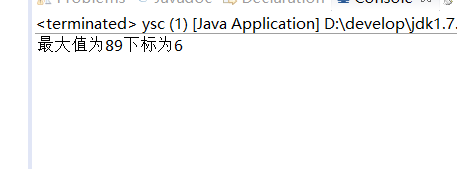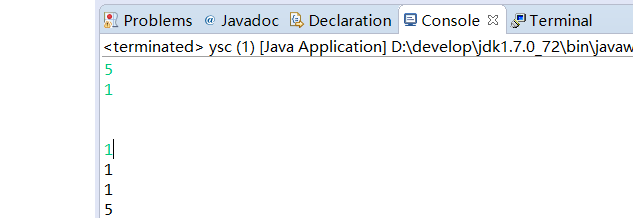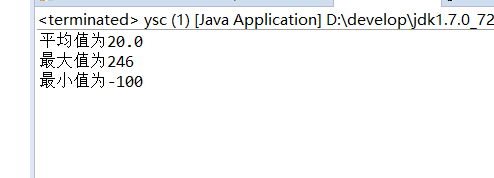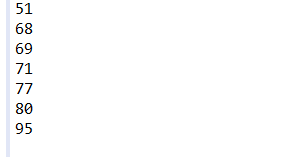第八次上机作业
1、编写一个简单程序,要求数组长度为5,分别赋值10,20,30,40,50,在控制台输出该数组的值。(知识点:数组定义和创建、一维数组初始化)[必做题]•
package abc;
public class ysc {
public static void main(String[] args) {
// TODO Auto-generated method stub
int shuzu[] = new int[]{10,20,30,40,50};
for (int i : shuzu) {
System.out.println(i);
}
}
}

2、将一个字符数组的值(neusofteducation)拷贝到另一个字符数组中。(知识点:数组复制) [必做题]•
package abc;
public class ysc {
public static void main(String[] args) {
// TODO Auto-generated method stub
char[] shuzu = new char[]{'a','b','c','d','o','f','t',};
char[] copy = new char[16];
System.arraycopy(shuzu, 0, copy, 0, shuzu.length);
for (char c : copy) {
System.out.println(c);
}
}
}

3、给定一个有9个整数(1,6,2,3,9,4,5,7,8)的数组,先排序,然后输出排序后的数组的值。(知识点:Arrays.sort排序、冒泡排序)
package abc;
import java.util.Arrays;
public class ysc {
public static void main(String[] args) {
// TODO Auto-generated method stub
int shuzu[] = new int[]{1,6,2,3,9,4,5,7,8};
Arrays.sort(shuzu);
for (int i : shuzu) {
System.out.println(i);
}
}
}

4、 输出一个double型二维数组(长度分别为5、4,值自己设定)的值。(知识点:数组定义和创建、多维数组初始化、数组遍历)
package abc;
import java.util.Arrays;
public class ysc {
public static void main(String[] args) {
// TODO Auto-generated method stub
double a[][] = { { 1, 2, 3, 4 }, { 2, 3, 4, 5 }, { 3, 4, 5, 6 },
{ 4, 5, 6, 7 }, { 5, 6, 7, 8 } };
for (int i = 0; i < a.length; i++) {
for (int j = 0; j < a.length - 1; j++) {
System.out.print(a[i][j] + " ");
}
System.out.println();
}
}
}

5、 在一个有8个整数(18,25,7,36,13,2,89,63)的数组中找出其中最大的数及其下标。(知识点:数组遍历、数组元素访问) [必做题]?
package abc;
public class ysc {
public static void main(String[] args) {
// TODO Auto-generated method stub
int a[] = { 18, 25, 7, 36, 13, 2, 89, 63 };
int max = a[0];
int maxidx = 0;
for (int i = 0; i < a.length; i++) {
if (a[i] > max) {
max = a[i];
maxidx = i;
}
}
System.out.println("最大值为" + max + "下标为" + maxidx);
}
}

作业
6、将一个数组中的元素逆序存放(知识点:数组遍历、数组元素访问
package abc;
import java.util.Scanner;
public class ysc {
public static void main(String[] args) {
// TODO Auto-generated method stub
Scanner input = new Scanner(System.in);
int a[] = new int[5];
for (int i = a.length; i > 0; i--) {
a[i - 1] = input.nextInt();
}
for (int i = 0; i < a.length; i++) {
System.out.println(a[i]);
}
}
}

7. 将一个数组中的重复元素保留一个其他的清零。(知识点:数组遍历、数组元素访问)
package abc;
import java.util.Scanner;
public class ysc {
public static void main(String[] args) {
// TODO Auto-generated method stub
Scanner input = new Scanner(System.in);
int a[] = new int[5];
for (int i = 0; i < a.length; i++) {
a[i] = input.nextInt();
}
for (int i = 0; i < a.length - 1; i++) {
for (int j = i + 1; j < a.length; j++) {
if (a[i] == a[j]) {
a[j] = 0;
}
}
}
for (int i = 0; i < a.length; i++) {
System.out.println(a[i]);
}
}
}

8、给定一维数组{ -10,2,3,246,-100,0,5},计算出数组中的平均值、最大值、最小值。(知识点:数组遍历、数组元素访问)
package abc;
import java.util.Scanner;
public class ysc {
public static void main(String[] args) {
// TODO Auto-generated method stub
int a[] = { -10, 2, 3, 246, -100, 0, 5 };
int max = a[0], min = a[0];
int sum = 0;
double avg = 0;
for (int i = 0; i < a.length; i++) {
sum += a[i];
avg = sum / 7;
if (a[i] > max) {
max = a[i];
}
if (a[i] < min) {
min = a[i];
}
}
System.out.println("平均值为" + avg);
System.out.println("最大值为" + max);
System.out.println("最小值为" + min);
}
}

9、使用数组存放裴波那契数列的前20项 ,并输出 1 1 2 3 5 8 13 21
package abc;
public class ysc {
public static void main(String[] args) {
// TODO Auto-generated method stub
int a[] = new int[20];
a[0] = 1;
int x = 1;
int y = 1;
int z = 1;
for (int i = 0; i < a.length; i++) {
a[i] = z;
z = x + y;
x = y;
y = z;
}
for (int i = 0; i < a.length; i++) {
System.out.println(a[i]);
}
}
}

10、生成一个长度为10的随机整数数组(每个数都是0-100之间),输出,排序后,再输出
package abc;
import java.util.Arrays;
import java.util.Random;
public class ysc {
public static void main(String[] args) {
// TODO Auto-generated method stub
Random r = new Random();
int a[] = new int[10];
for (int i = 0; i < a.length; i++) {
a[i] = r.nextInt(100);
System.out.println(a[i]);
}
Arrays.sort(a);
System.out.println("排序后输出");
for (int i = 0; i < a.length; i++) {
System.out.println(a[i]);
}
}
}



